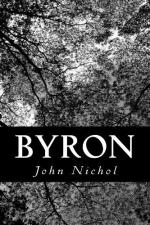Among the incidents of this residence were, the homage paid to the poet by a party of Americans; the painting of his portrait (and that of La Guiccioli) by the artist West, who has left a pleasing account of his visits; Byron’s letter making inquiry about the country of Bolivar (where it was his fancy to settle); and another of those disturbances by which he seemed destined to be harassed. One of his servants—among whom were unruly spirits, apparently selected with a kind of Corsair bravado,—had made an assault on Count Pietro, wounding him in the face. This outburst, though followed by tears and penitence, confirmed the impression of the Tuscan police that the whole company were dangerous, and made the Government press for their departure. In the midst of the uproar, there suddenly appeared at the villa Mr. Leigh Hunt, with his wife and six children. They had taken passage to Genoa, where they were received by Trelawny, in command of the “Bolivar”—a yacht constructed in that port for Lord Byron, simultaneously with the “Don Juan” for Shelley. The latter, on hearing of the arrival of his friends, came to meet them at Leghorn, and went with them to Pisa. Early in July they were all established on the Lung’ Arno, having assigned to them the ground floor of the palazzo.
We have now to deal briefly—amid conflicting asseverations it is hard to deal fairly—with the last of the vexatiously controverted episodes which need perplex our narrative. Byron, in wishing Moore from Ravenna a merry Christmas for 1820, proposes that they shall embark together in a newspaper, “with some improvement on the plan of the present scoundrels,” “to give the age some new lights on policy, poesy, biography, criticism, morality, theology,” &c. Moore absolutely refusing to entertain the idea, Hunt’s name was brought forward in connexion with it, during tho visit of Shelley. Shortly after the return of the latter to Pisa, he writes (August 26) to Hunt, stating that Byron was anxious to start a periodical work, to be conducted in Italy, and had proposed that they should both go shares in the concern, on which follow some suggestions of difficulties about money. Nevertheless, in August, 1821, he presses Hunt to come. Moore, on the other hand, strongly remonstrates against




